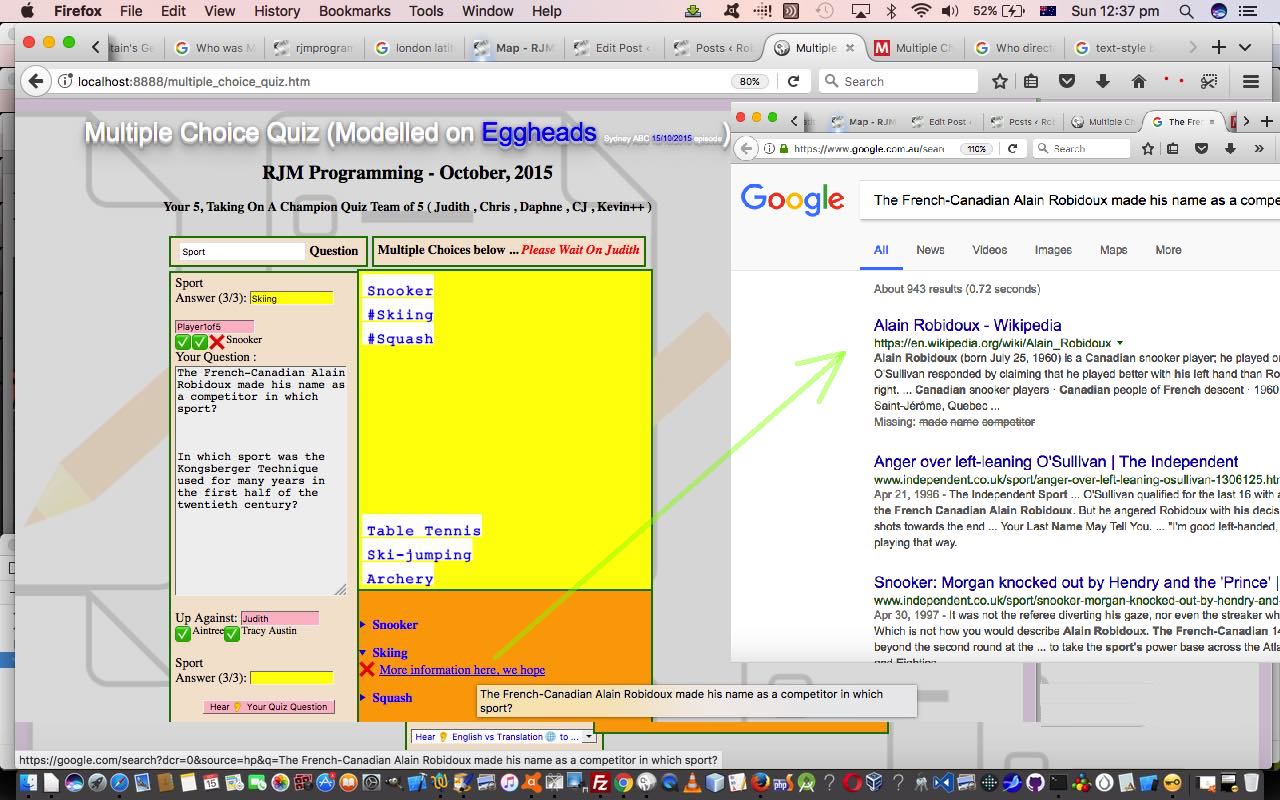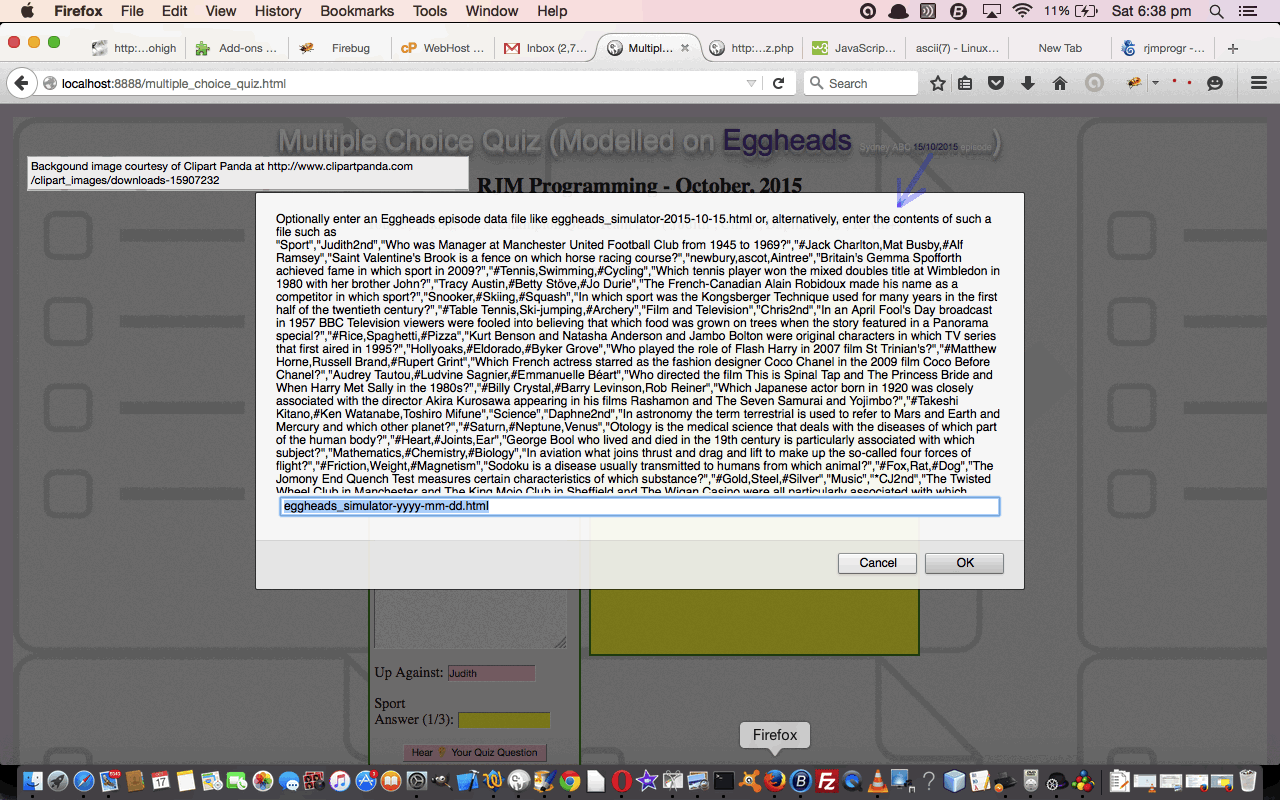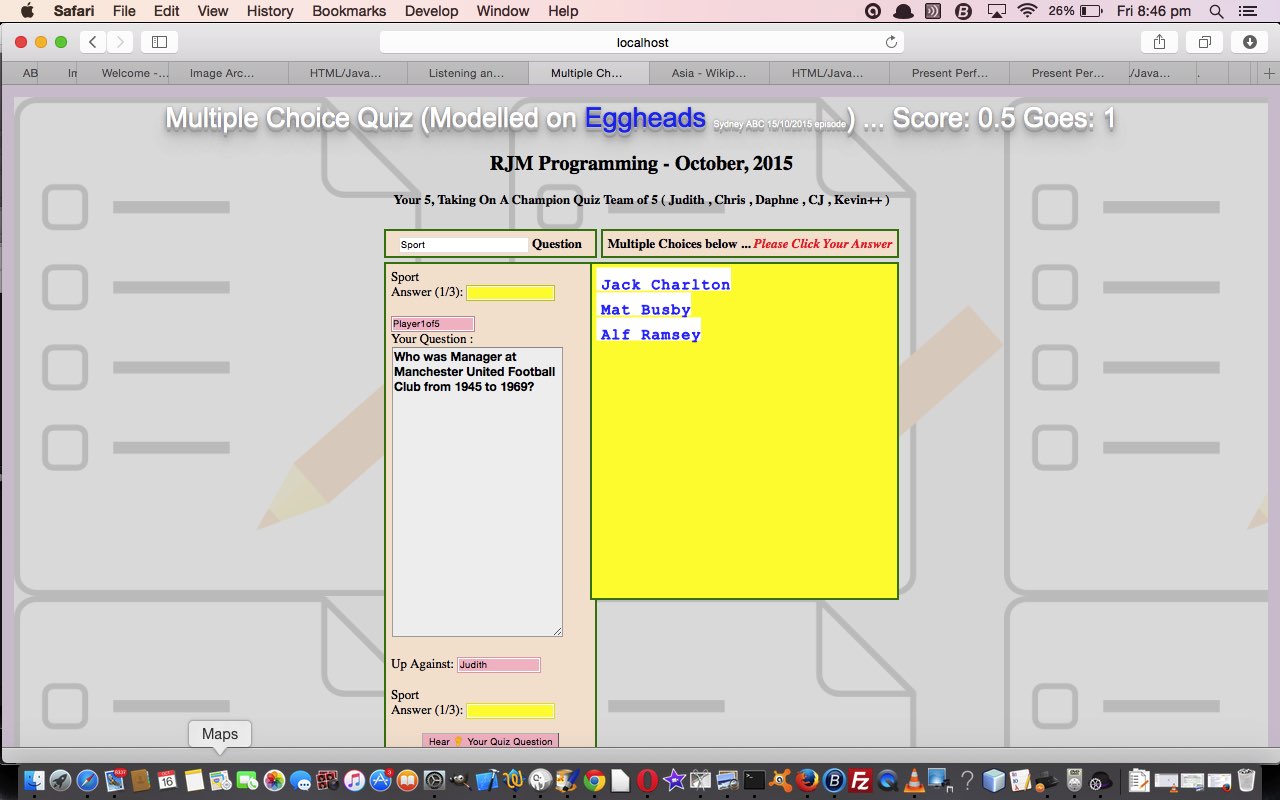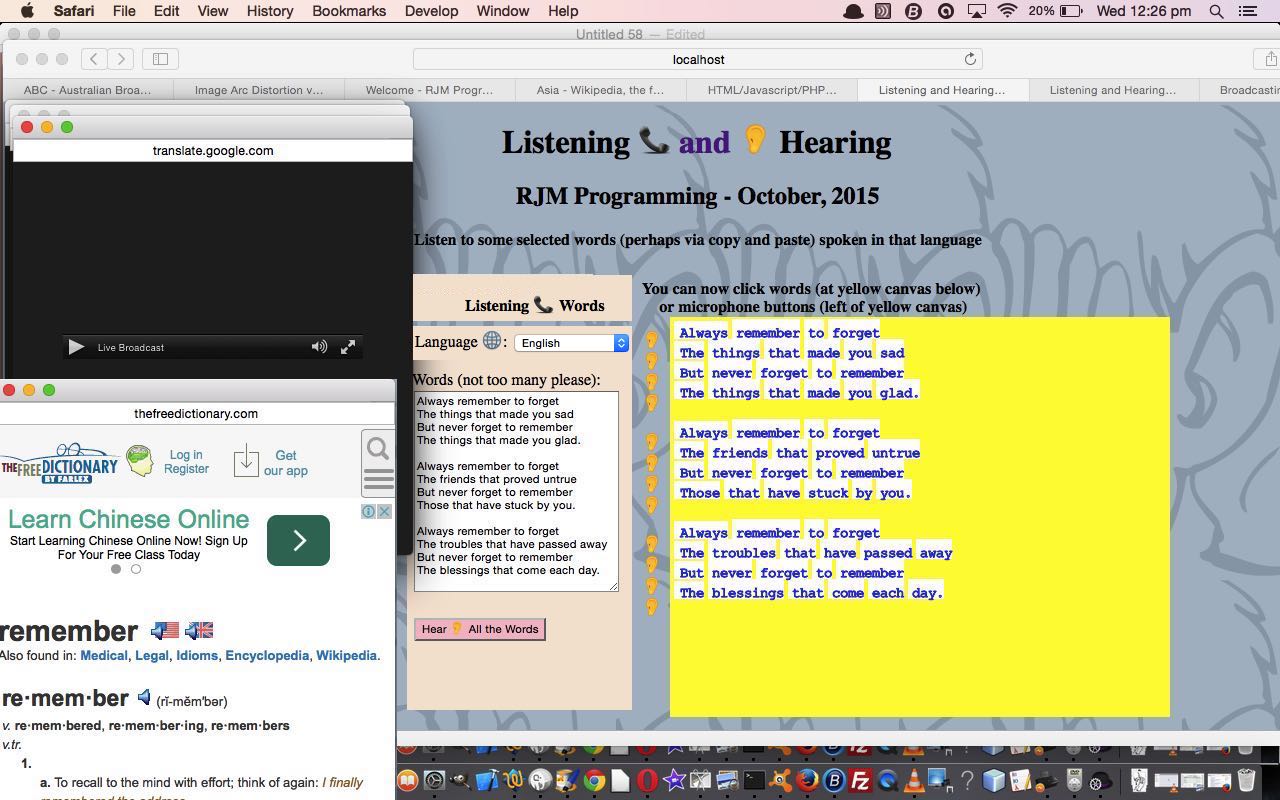The previous HTML/Javascript Multiple Choice Quiz Administration Tutorial saw us create a Multiple Choice Quiz based on the “pub quiz” style game called Eggheads “where a challenger team of 5 tries to defeat a champion team of 5 in a topic based head to head quiz followed by a General Knowledge round of the survivors to determine a winner”. In the hurly burly of this game, there is not much time for reflection, in that almost impossible (chortle, chortle) scenario of you, the user, answering wrongly, and so wanting to know in what way you went wrong. So, today, we add to the “explanation” side of this quiz, allowing you to look up Google should that impossible (chortle, chortle) scenario actually happen.
And this brings us to our latest “reveal” friends of late, the HTML5 details tag and its nested summary tag, because there are several benefits to involving them in a multiple choice quiz, in that …
- it is very intuitive to choose to click these HTML elements to “reveal” an answer
- our efforts at hiding “giving the game away” by not supplying information in the title= property that with a “hover” onmouseover event triggering, might give the game away, is a doddle with details/summary usage because you can naturally hide as much as you want to in the details.innerHTML property that is not shown (which, with no clicking, is just the summary.innerHTML)
- the details/summary bits can hang around while the Egghead answers their question, giving you time for a quick skeg on Google (off wrong answer details.innerHTML content) … try doing that on the show itself, and see what happens?!
- as so often we feel like using details/summary functionality, again, it is an optional piece of functionality, just introducing an alternative way for the user to answer the quiz question, not interfering with any of the other ways to answer the question … the “third buzzer”?!
- as you may glean from right hand part of table below, in limited screen widths, the details/summary functionality can serve as the whole shindig to do with the game, at least on non-mobile platforms, if we add, just onto the details.title property the wording of the question
Maybe you can decide this for yourself, because today’s work does not “clobber” the old approach without details/summary, so maybe you can decide for yourself below …
| Old Eggheads Game | New details/summary Eggheads Game |
|---|---|
We’ll leave you with the HTML and Javascript multiple_choice_quiz.htm downloadable source code that changed for this details/summary multiple choice quiz game help in this way.
Previous relevant HTML/Javascript Multiple Choice Quiz Administration Tutorial is shown below.
We continue on with the Multiple Choice Quiz modeled on the rules of a UK (BBC2) quiz television show called Eggheads, where a challenger team of 5 tries to defeat a champion team of 5 in a topic based head to head quiz followed by a General Knowledge round of the survivors to determine a winner, first started yesterday with HTML/Javascript Multiple Choice Quiz Primer Tutorial as shown below.
Today we want to talk about …
- Content Management strategies
- Roles for Client and Server in Content Management
… with respect to extending the functionality of our Multiple Choice Quiz.
Yesterday, we left off with a web application that felt “hard-coded”, as it was restricted to the scenario of the questions from a particular episode of the UK (BBC2) quiz television show called Eggheads aired on Sydney ABC television on 15/10/2015.
It’s true that it kind of felt hard-coded, but if you examined that HTML/Javascript code as of yesterday …
For programmers interested in HTML and Javascript and CSS code (especially as you don’t need any special web hosting to test today’s code) you can see this at multiple_choice_quiz.html and because today’s code was based so much on the recent HTML/Javascript Hearing and Listening Primer Tutorial we also present, today, a “how we got there” differences link to peruse here.
… you may have concluded that the whole workings of the web application could be changed merely by changing the contents of the Javascript array variable “qanda”. So if we can control the contents of “qanda” we can make the web application be completely different. This is similar to CMS (Content Management Systems) that allows “administrator” users control the contents of particular data parts of the web application, effectively, in the case of blog systems like WordPress or Drupal or Tiki Wiki or Joomla, allowing the insertion and updating and deleting of data in MySql databases associated with those websites. We set up a means to come to the same ends, today, with our Multiple Choice Quiz, except that instead of a database as a data repository, we are going to set up a system of flat files to use as the data source.
Now, above, we’ve mentioned (flat) files, which many of you would recognize as needing a serverside language like PHP to maintain that system, at least dynamically within the web application. That is true, as it is true for WordPress and Drupal and Tiki Wiki and Joomla also, but we also want to show that you can still work this without the serverside language web hosting, but manage the flat files yourself and upload these flat files (via ftp (or sftp) perhaps … and a Stop Press here is that the HTML/Javascript code will handle the simulation of a non-existant PHP code scenario if they enter content data at the Javascript prompt window presented and subsequently choose Cancel at the next prompt window prompting for a filename) to the proper place (where the HTML/Javascript exists), where we apply Client Pre-Emptive Iframe logic to our HTML/Javascript code, which is called multiple_choice_quiz.html with differences to yesterday outlined here.
Maybe you can see from the HTML/Javascript code that Client Pre-Emptive Iframe thoughts can decouple the “Client” from the “Server” to allow for ftp uploading scenarios independent of serverside logic.
We want to show that, but we don’t want to leave out that the addition of serverside processes enhances such data driven web applications no end, and that is why just about every CMS in the world has a serverside part to it, and usually involves a database in which to store the data controlled by administrator users (though there are some that use flat files, as well, out there).
This Content Management talent that PHP and other serverside languages possess is another of the hundreds of reasons, web hosting with serverside languages such as PHP adds so much to the web experience for so many people using the net.
So our HTML/Javascript today is designed to live without or work with the new PHP code we’ve introduced with multiple_choice_quiz.php. The PHP can write out a Multiple Choice Quiz “qanda” array variable data snippet into our “eggheads_simulator_yyyy-mm-dd.html” Client Pre-Emptive Iframe scenario, but the HTML/Javascript can accept this data from any approach that got it there, which could have been via ftp uploading means, that didn’t involve PHP serverside work, at all. The PHP works with the HTML/Javascript by working with content and file name variables POSTed to it from the HTML/Javascript form we’ve introduced today, but the PHP is also designed for those web administrator users out there, who may be classed as Content Managers, by also being able to act as a CMS type of arrangement when called this way, without the $_POST nor $_GET parameters.
So you can see now, why all CMS divide users into those with different roles, but today, with our simplified scenario, you can all be normal users and we’ve made it so that you can all be administrator users able to add content to our Multiple Choice Quiz web application.
Again we leave you with a live run link to take on the “Egghead” simulator that allows for user (and all users are administrators, for our purposes today) entered episode (data) information. We hope some or all of the concepts here are some kind of help to you.
Previous relevant HTML/Javascript Multiple Choice Quiz Primer Tutorial is shown below.
Today’s web application is a Multiple Choice Quiz modelled on the rules of a UK (BBC2) quiz television show called Eggheads, where a challenger team of 5 tries to defeat a champion team of 5 in a topic based head to head quiz followed by a General Knowledge round of the survivors to determine a winner.
In the real Eggheads there are sudden death questions, as necessary, in all rounds, but with our rules, we only do this for the final General Knowledge collaborative round.
This web application shares the yellow HTML canvas element as discussed in the recent HTML/Javascript/PHP Broadcast and Listen CSS Tutorial as well. This time, though, with the printing out, there are implied buttons under each word, via a white background (done with a call to the fillRect() HTML canvas method) to those bits of the canvas element. To click on one of these white areas …
- allows the challenger team to answer the question posed … and then …
- sets up the corresponding champion team question, updating scores and answer information
… using an HTML canvas element onclick event detection of mouse co-ordinates to achieve this functionality.
The web application makes a lot of use of the Javascript setTimeout method to synchronize all the toings and froings in an order that makes sense, and simulates the “Egghead” champion team, who, after all, are not with you, so their actions are delayed. By the way, with all this, don’t worry that there would be no chance of you winning against the champion “Egghead” team. The “warts and all” mistakes made by the “Eggheads” team in the episode aired on the 25/10/2015 in Sydney ABC are mimicked in the answers of the champion team you are up against, and you can win if you are “on your toes”.
We’d like to thank Clipart Panda for the background image used today in that similar manner as discussed with HTML/Javascript/PHP Broadcast and Listen CSS Tutorial.
For programmers interested in HTML and Javascript and CSS code (especially as you don’t need any special web hosting to test today’s code) you can see this at multiple_choice_quiz.html and because today’s code was based so much on the recent HTML/Javascript Hearing and Listening Primer Tutorial we also present, today, a “how we got there” differences link to peruse here.
We leave you with a live run link to take on the “Egghead” simulator!
Previous relevant HTML/Javascript Hearing and Listening Primer Tutorial is shown below.
We’ve got a web application on the theme of Listening and Hearing, today, written such that it doesn’t need serverside (in our case, PHP) constituents, just HTML and Javascript and CSS, with a lot of help from various sources as per …
- Google Translate … specifically its incredibly useful text to speech service … thanks, heaps … by the way, you may be asked to fill in a Captcha “puzzle” when accessing the text to speech functionality when using the live run, and this may only happen once a session
- The Free Dictionary … thanks, again
- Clipart Panda … for the background image … and the same configuration of this as we mentioned in HTML/Javascript/PHP Broadcast and Listen CSS Tutorial
- A Poem courtesy of this great link … thanks
We’ve designed this web application with ESL students in mind, but it might be useful for other purposes. The idea is the user types, or copies and pastes some wording of interest into the “words” textarea and sees it presented in the yellow HTML canvas element, printed out slowly in that same method as discussed in HTML/Javascript/PHP Broadcast and Listen CSS Tutorial as well. This time, though, with the printing out, there are implied buttons under each word, via a white background (done with a call to the fillRect() HTML canvas method) to those bits of the canvas element. To click on one of these white areas …
- opens a window.open() popup window of The Free Dictionary lookup for that word if your Language you’ve chosen in the HTML select (dropdown) element is English
- opens a window.open() popup window of Google Translate text to speech for that word in the Language you’ve chosen in the HTML select (dropdown) element
There are limits to the amount of text Google Translate text to speech allows, and in some cases where you leave totally blank lines in your text, we may be able to “chunk” the text into several calls to Google Translate text to speech when you’ve pressed the “Hear 👂 All the Words” button.
Also, as in HTML/Javascript/PHP Broadcast and Listen CSS Tutorial, we’ve included some Internationalization Emoji character helpers and like there, we found Emojipedia a great place to look up the concepts with better detail at the File Format Info website.
ESL students will probably have already experienced a variety of English accents, and there is no doubt this is a big thing to overcome in learning English, along with all the other challenges to do with learning another language. The Google Translate text to speech is no different in the sense that there is an accent you should not think is going to be a typical accent, necessarily, to do with living where you’re going to be living. But it does give you some guidelines into how words are pronounced, and it is good to have heard a word sometimes, before you hear it being spoken by a very fast speaker, for instance. So, why not copy and paste some words off the Internet, and see how they sound by using this live run link.
For you programmers interested in HTML and Javascript and CSS code (especially as you don’t need any special web hosting to test today’s code) you can see this at listen_to.html and because today’s code was based so much on the supervisor HTML code of HTML/Javascript/PHP Broadcast and Listen CSS Tutorial we also present, today, a “how we got there” differences link to peruse here.
If this was interesting you may be interested in this too.
If this was interesting you may be interested in this too.
If this was interesting you may be interested in this too.
If this was interesting you may be interested in this too.






